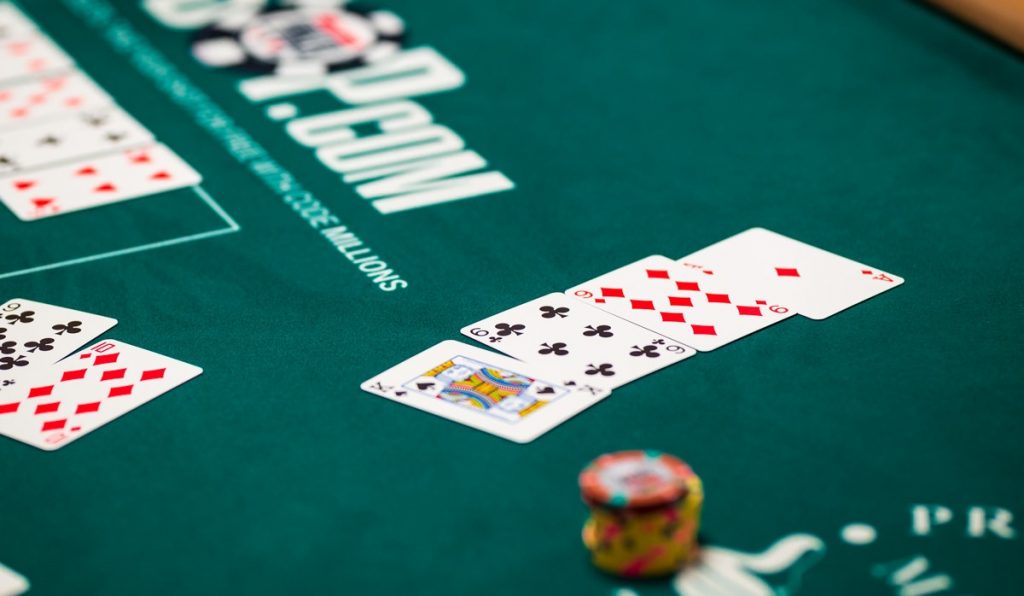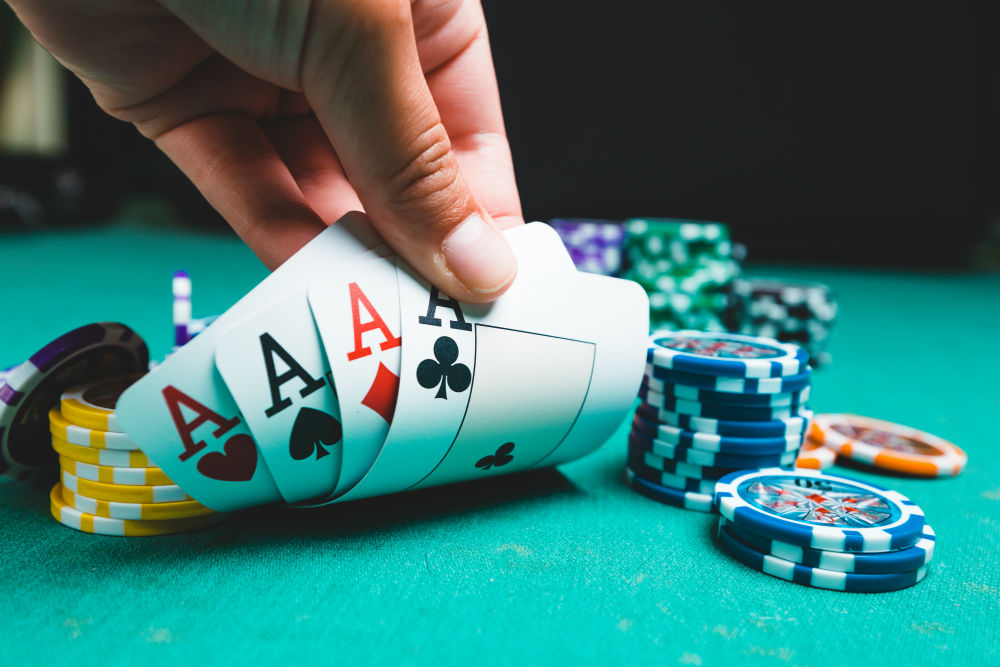What is Pot Limit Omaha
A form of community card poker, like Texas Hold’em, in which the maximum betting limit is determined by the size of the current pot.
How it is played
Each player is dealt four cards that only they see in the preflop phase. Three cards are placed in the middle of the table in the flop phase, one more in the turn phase and one more in the river phase. The 5 cards thus placed in the centre of the table are community cards, which all players can use to form their hand.
There are bets after each of the four phases, where players can bet, raise a previous bet from another player or fold and, as mentioned above, in the Pot Limit variant the maximum bet is determined by the size of the pot at the time.
In Omaha, therefore, we have four cards in the hand that only we can see, and five cards on the table that everyone can use. However, not just any combination of these is valid. An Omaha hand must be made up by using two (and only two) of the four cards in our hand in combination with three (and only three) of the community cards.
Game Strategy

Pot Limit Omaha is a very fun game, which tends to see a lot of action plus generally requires a lot of caution. It is advisable to have between 20 and 30 times the amount you bring to the table in order to be able to play free from the stress of often having to decide whether to bet your entire stack on a high-potential hand. In this game there are many situations that are difficult to solve, but on the other hand, it is also relatively easy to count the cards that, if they come out, will give you the victory, to study the probability of this happening and, therefore, to make decisions with a predictably positive expectation.
Pre-flop strategy
Before the flop, hand selection is very important. Any set of four cards dealt to us can become a winner, that is true, but only combinations in which all four have some interrelation between them have a sufficiently high probability of this happening to become winners in the long run.
In general, we will be looking for such cards. Hands like AAKQ, KQJ9, 8765… in the different situations in which they can be played, are the ones we look for.
As for aggressiveness at this stage, it depends on the table and our ability to play after the flop. No hand is good enough to win by itself (this truth is much more indisputable in Omaha than in Hold’em), so the effectiveness of raising before the flop at tables that are not very selective, or when we are not very solvent in the later phases, is, at least, debatable.
Flop strategy

On the flop, we know a very large percentage of the total information we will have at the end. At this stage, the biggest decision to make is whether to stay in the hand or fold. Basically, we will fold whenever we don’t have a hand that has a good enough chance of winning. From the betting patterns of the opponents before and on the flop, we can more or less estimate the hands we are facing, and accurately calculate how many cards will be enough to complete a winning hand.
Let’s think, if our hand is As9s8h7h and the flop shows 6s5sKc, we can estimate that there are 17 cards that, if dealt, would complete a winning hand for us (4 fours, 3 sevens, 3 eights, 3 nines and 4 spades). We do not count the Ks, because in that case our play would be complete, but we could not be sure that it would be a winning hand.
With 17 “winning” cards our hand is very strong and, if we play it aggressively at this point, we can even get people to fold before it is even completed, or get all our money in the middle and see the two remaining cards and not have to make complex decisions on the turn if our hand is not completed by then.
On the other hand, the structure of Pot Limit means that this phase is not the best for protecting our “made” hands (such as high three of a kind) in flops with a complicated texture (connected cards and two of a kind, for example). Therefore, we will also have to make complex decisions and find a balance in the bets to be made in this phase to try to protect the best “temporary” hand (without offering to see cards for free to the opponents) but without risking too much in case the opponents complete their projects.
Turn strategy
The turn is the phase in which the best “temporary” hand must be protected. A bet of the size of the pot at this stage, coupled with the fact that there is only one card left to go and complete possible draws, means that none of these draws have any mathematical justification for seeing the bet, no matter how dangerous the cards on the table are.
The only exception to this point is the situation where we believe that an opponent also has the best temporary hand, as we do, and an improving project. Suppose we have 9h8s7c6d and the table contains 10h8h6cKc. If another player has QhJc9c7h or KhKs9c7h it is obvious that betting on the turn has a negative expectation, since in case our straight holds we will only split t he pot with our opponent, and if any of his draws are completed we will lose everything.
In any case, if the table is very aggressive many times the money will be in the middle on the flop, and the turn will be a mere formality.
River strategy
On the river, we already have all the information. Our hand is formed, complete or not as the best possible, and we can almost certainly estimate the opponents’ hand. Therefore, at this stage it is all about getting as much extra money as possible, in case we have the best hand, and deciding whether to fold or not in case we don’t, depending on what the opponents are doing and what we think they are holding. It is also a good time to bluff if the betting patterns are consistent, and to be bluffed and detect those bluffs based on those patterns and other information we may know about the opponents (notes, gestures, mannerisms).
Do we bet the pot or just part of it? If the opponent bets the pot, is he bluffing or does he have the best play? Why would he bet the maximum if he has the best play, taking the risk that I will fold, if with a smaller bet he could force me to see? But, on the other hand, what if he’s bluffing, and he knows I’m thinking this very thing?
Well, no one said making these decisions was easy. But that’s the essence of poker.
Summary and Practical Tips
- Enter the tables with no more than 5% of your available poker bankroll.
- Play at tables that you can control and that are consistent with your type of play.
- Always try to play sets of cards where all four received cards are interrelated.
- Only bet preflop if you are able to be consistent with your subsequent play and against suitable opponents.
- On the flop, fold without contemplation if your hand doesn’t have much chance of becoming a winner in the end. And if it does, play as aggressively as possible.
Protect your hands on the turn with maximum size bets, so as not to give your opponents a mathematical chance of making the right decisions with a positive long-term expectation.
Sometimes bet the maximum on the river with the best hand so as not to be too predictable with your bets, but usually bet less to try to scrape up some extra money.
Don’t be afraid to see an inconsistent bet on the river from an aggressive opponent, no matter how big that bet is, if your hand has a chance of winning, even if it’s not the best possible play. You’ll lose sometimes, but you’ll win more pots than you think and you’ll be sending a clear message to the table: it doesn’t pay to bluff.

